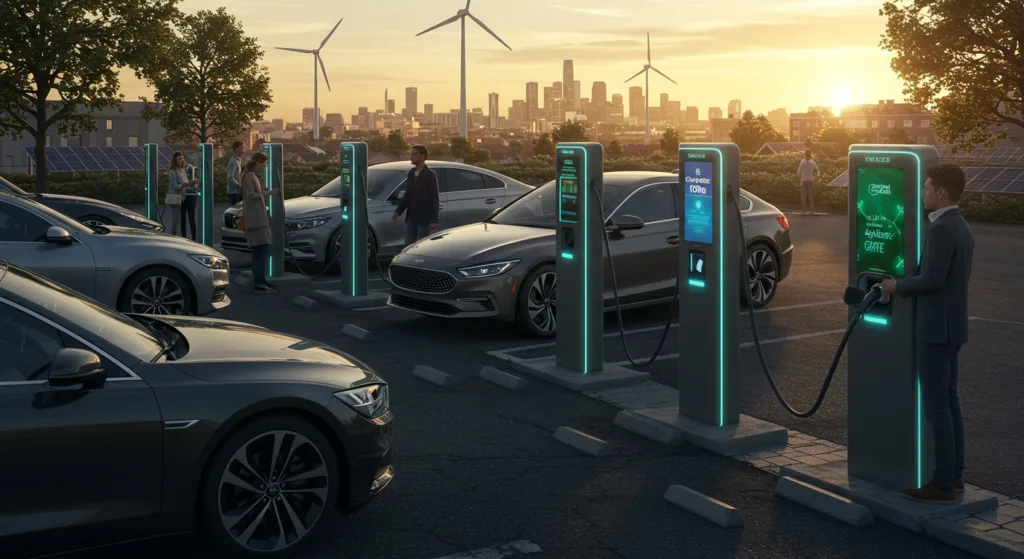Is Free Electric Car Charging a Myth or Reality?

The idea of charging an electric car for free sounds too good to be true, but in many cases, it is a reality. Free EV charging exists through public stations, government incentives, and corporate sponsorships. However, it’s essential to understand the real value behind these opportunities and whether they truly provide cost-free energy or if there are hidden expenses to consider. Let’s explore where and how you can charge your EV for free while avoiding potential pitfalls.
How Public Charging Stations Offer Free Charging
Public charging stations are a significant source of free EV charging, but not all are entirely cost-free. Many locations offer free charging as a perk to attract customers, encourage sustainable transportation, or comply with local incentives. Here’s how public stations provide free electricity:
1. Retail and Business-Sponsored Charging
Many businesses install free charging stations to attract EV owners and increase foot traffic. Some common locations include:
- Shopping malls and retail stores – Chains like Walmart, Whole Foods, and Target provide free Level 2 charging at select locations.
- Hotels and restaurants – Many hotels, including Marriott and Hilton, offer complimentary EV charging for guests.
- Supermarkets and grocery stores – Chains like Lidl and Aldi in Europe have introduced free charging for customers.
2. Workplace Charging Programs
Companies are increasingly installing free Electric Car chargers in office parking lots. According to a 2023 report by the U.S. Department of Energy, nearly 90% of EV charging happens at home or work, making workplace charging an excellent option for free daily top-ups.
3. Utility Company Pilot Programs
Some utility providers offer free Electric Car charging during specific hours to balance grid demand. For example:
- California’s PG&E runs pilot programs with free off-peak charging hours.
- UK’s Octopus Energy has tariffs allowing free charging during low-demand periods.
4. Free Charging at Municipal and Government Locations
Certain cities provide free public charging at government buildings, libraries, and parking garages as part of their sustainability initiatives.
While these options offer free energy, they often come with restrictions such as usage limits, time restrictions, or membership requirements.
Government Incentives and Free Charging Benefits
Governments worldwide support free EV charging through subsidies, grants, and tax benefits to encourage electric vehicle adoption. These incentives vary by country and region but provide excellent opportunities for cost-free charging.
1. Free Charging as Part of EV Purchase Incentives
Many countries bundle free charging incentives with the purchase of an EV:
- United States: Some states, such as California and New York, provide rebates for home charging equipment and public charging credits through programs like the Clean Vehicle Rebate Project (CVRP).
- Germany: Offers EV buyers free access to EnBW and Allego public charging stations for a limited time.
- China: Local governments in cities like Shenzhen provide free access to municipal EV chargers.
2. Free Charging Through Renewable Energy Programs
Certain regions promote solar-powered EV charging stations where users can charge for free. For example:
- Sweden and Norway have deployed solar-powered charging hubs that allow drivers to charge their cars at no cost.
- California has over 500 solar-powered charging stations available for public use.
3. Free Charging in Low-Emission Zones
Some cities offer free EV charging to promote green transportation:
- London’s Ultra-Low Emission Zone (ULEZ) provides free charging incentives to EV owners in certain areas.
- Amsterdam and Oslo offer free public charging for electric taxis and delivery vehicles.
Government programs like these help reduce costs for EV owners while promoting sustainable energy use. However, these incentives often change, so it’s important to stay updated on local policies.
Hidden Costs Behind “Free” Electric Car Charging
While free EV charging is a great benefit, it’s not always as free as it seems. Here are some hidden costs and considerations that EV owners should be aware of:
1. Time Limits and Usage Restrictions
Many free charging stations impose restrictions, such as:
- Limited charging time – Some free chargers allow only 30 minutes to 1 hour per session, which may not fully charge a battery.
- Membership requirements – Many stations require users to sign up for loyalty programs or subscriptions.
2. Indirect Costs from Paid Parking
Some “free” charging spots require you to pay for parking:
- Airport EV chargers may be free, but parking fees can add up quickly.
- Downtown public garages often offer free EV charging but charge high parking rates.
3. Peak-Hour Pricing and Future Fees
Some free charging networks introduce pricing after an initial free period:
- Tesla’s Destination Chargers were once free for all, but now some require payment.
- ChargePoint and EVgo have transitioned some free locations into paid ones over time.
4. Opportunity Costs of Slow Charging
Many free chargers are Level 2, which can take 4-8 hours for a full charge. If you need fast charging, free stations may not be the most efficient option.
Final Thoughts
Free EV charging is a real opportunity, but it requires planning. Understanding where and how to find it, as well as recognizing any hidden costs, can help maximize your savings while keeping your EV powered up.
💡 Tip:
“Always check for free charging perks when purchasing an EV—many automakers and retailers offer hidden deals that can save you hundreds per year!”
Where to Find Free Electric Car Charging Stations?

Finding free EV charging stations can help you save significantly on energy costs while maximizing your electric vehicle’s efficiency. While free charging is available in many locations, knowing where to look and how to access it is key. From mobile apps to retail partnerships and home solar charging, let’s explore the best ways to get free EV power.
Best Apps to Locate Free EV Charging Spots
Technology makes finding free charging stations easier than ever. Several apps help EV owners locate nearby chargers, check real-time availability, and filter for free options. Here are the top apps for finding free EV charging:
1. PlugShare (Global Coverage)
- One of the most popular EV charging apps, available worldwide.
- Filters allow users to search for free charging stations.
- Crowdsourced reviews provide insights into charger reliability.
2. ChargePoint (U.S., Canada, and Europe)
- Many ChargePoint stations are free at partner locations like workplaces and hotels.
- Allows users to see if a station is in use before driving to it.
3. Tesla’s In-Car Navigation (Tesla Vehicles)
- Tesla’s built-in system highlights free Tesla Destination Chargers.
- Offers trip planning to optimize free charging stops.
4. Google Maps & Apple Maps
- Both Google and Apple Maps now list EV charging stations.
- Users can search “free EV charging” to locate complimentary options nearby.
5. Electrify America & EVgo
- While primarily paid networks, both companies partner with retailers to offer limited-time free charging promotions.
📌 Pro Tip: Always check user reviews before heading to a charging station. Some free chargers may be out of service or require specific access codes.
Supermarkets, Hotels, and Workplaces Offering Free Charging
Many businesses now offer free EV charging as an incentive to attract customers or employees. Below are the best places to find complimentary charging:
1. Supermarkets & Retail Chains
Many grocery stores and big-box retailers provide free charging for customers, including:
- Walmart & Sam’s Club (U.S.) – Free EV charging at select locations.
- Lidl & Aldi (Europe) – Offer 30-60 minutes of free charging per visit.
- Whole Foods (U.S.) – Partnered with EVgo to provide free charging at select stores.
- IKEA (Global) – Offers free EV charging at most locations.
2. Hotels with Free EV Charging
Many hotels now provide complimentary Level 2 charging for guests:
- Hilton & Marriott – Many properties offer free chargers.
- Best Western & Holiday Inn – Some locations provide EV charging as an amenity.
- Eco-friendly & Boutique Hotels – More sustainable hotels are adopting free EV charging.
📌 Tip: Use PlugShare or call ahead to confirm if a hotel offers free charging before booking.
3. Workplaces with Free Charging
Many employers are installing EV chargers as part of their sustainability efforts:
- Google, Apple, and Microsoft provide free workplace charging for employees.
- Government buildings in cities like Los Angeles and Amsterdam offer free chargers.
- Universities & Hospitals often provide free EV charging for staff and students.
📌 How to Get Free Charging at Work?
- Ask your employer if they have or plan to install EV chargers.
- Check employee benefits—some companies offer charging reimbursement.
How to Use Solar Panels for Free Home Charging
Charging an EV at home can be expensive, but solar panels provide a way to charge your car for free once installed. Here’s how:
1. How Much Solar Power Do You Need?
- A typical EV consumes 3-4 miles per kWh.
- If you drive 1,000 miles per month, you’ll need about 250-300 kWh.
- A 5 kW solar system can generate enough power for most daily EV needs.
2. What Are the Costs & Savings?
- Solar panel installation cost: $10,000 – $20,000 (after incentives).
- Savings: Up to $1,500 per year in electricity costs.
- Break-even point: Typically 5-7 years, after which charging is free.
3. Battery Storage for 24/7 Free Charging
- If you charge at night, consider solar battery storage (e.g., Tesla Powerwall or LG Chem).
- Batteries store excess solar energy, making free charging available day & night.
📌 Tip: Some regions offer solar tax credits and rebates that reduce installation costs, making it easier to set up free EV charging at home.
By combining free public chargers, workplace perks, and home solar charging, EV owners can significantly cut costs and even charge their vehicles without ever paying for electricity!
Quote:
“The future of transportation isn’t just electric—it’s also smarter, cheaper, and more sustainable. Free charging is just the beginning.”
Secret Hacks to Maximize Free EV Charging

Getting free EV charging is great, but maximizing these opportunities can save you even more money in the long run. Many drivers overlook strategies like loyalty programs, off-peak deals, and driving techniques that extend battery life and minimize paid charging. Here’s how to take full advantage of free charging opportunities and reduce your overall EV energy costs.
Loyalty Programs and Membership Perks for Free Charging
Many Electric Car charging networks and retailers offer loyalty rewards that allow drivers to access free charging. By signing up for these programs, you can accumulate free charging credits or unlock complimentary sessions.
1. Charging Networks with Free Membership Perks
Several charging providers offer free energy through memberships:
- ChargePoint Rewards – Earn credits for every charge, which can be redeemed for free sessions.
- EVgo Rewards – Customers can accumulate points and exchange them for free charging.
- Electrify America Pass+ – While primarily a discount program, it occasionally offers free charging promotions for members.
📌 Tip: Always check for referral bonuses. Some networks provide free charging credits when you invite a friend to sign up.
2. Retail and Grocery Store Loyalty Programs
Many retail chains offer exclusive free EV charging for loyalty members:
- Walmart & Sam’s Club – Free charging promotions for certain membership tiers.
- Kroger & Albertsons – Loyalty members get free or discounted charging at select locations.
- Costco – Some locations provide free charging for Costco members.
3. Auto Manufacturer Charging Perks
When purchasing an EV, many automakers include free charging benefits:
- Tesla Supercharging – Some Tesla models (like early Model S and Model X) include free lifetime Supercharging.
- Volkswagen ID.4 – 3 years of free Electrify America charging.
- Hyundai & Kia – Free charging credits with ChargePoint and Electrify America.
📌 Tip: If you’re buying a new EV, always ask about charging perks. Some dealerships don’t openly advertise these programs, but they exist!
Off-Peak and Promotional Deals to Reduce Electric Car Charging Costs
Many charging networks and utility companies offer off-peak pricing or limited-time promotions that allow drivers to charge for free or at significantly lower rates.
1. Off-Peak Charging Discounts
- Tesla Time-of-Use Pricing – Tesla owners can charge for $0.09 per kWh in off-peak hours, nearly free compared to peak rates.
- Public Utility Discounts – Some utility companies offer free or heavily discounted charging overnight:
- PG&E (California) – Free EV charging from midnight to 6 AM in some areas.
- Octopus Energy (UK) – Free charging during “Agile” tariff hours.
📌 Tip: If your local power company offers a time-of-use (TOU) plan, enroll in it to access lower or free charging rates.
2. Seasonal & Promotional Free Charging Events
Many charging networks and automakers run limited-time promotions, including:
- Earth Day (April 22nd) – Many networks provide free charging on this day.
- National Drive Electric Week (September) – Free EV charging events nationwide.
- Black Friday & Holiday Promotions – Some stores provide free charging during the shopping season.
3. Free Charging at Dealerships
- Many EV dealerships allow free test-drive charging even if you don’t buy the car.
- Tesla, Nissan, and BMW dealerships sometimes provide free Supercharging to attract potential buyers.
📌 Tip: Always check manufacturer websites and EV forums for upcoming charging deals.
Using Regenerative Braking to Extend Your Electric Car’s Range
One of the most overlooked ways to reduce Electric Car charging costs is by maximizing energy efficiency. Regenerative braking helps recover lost energy, reducing the frequency of charging stops.
1. How Regenerative Braking Works
- When you lift your foot off the accelerator, the EV’s motor reverses into a generator, converting motion back into electricity.
- This energy is stored in the battery, extending your range and reducing the need for external charging.
2. Best Driving Habits to Maximize Regenerative Braking
- Use one-pedal driving – EVs like the Tesla Model 3 and Nissan Leaf allow you to control acceleration and braking with one pedal.
- Coast instead of hard braking – The longer you allow regenerative braking to work, the more energy is recovered.
- Drive in eco-mode – Many EVs have settings that increase regenerative braking efficiency.
3. How Much Energy Can You Recover?
- Studies show regenerative braking can recover up to 30% of lost energy, significantly improving mileage.
- In city driving with frequent stops, regen braking can extend range by 10-15% compared to highway driving.
📌 Tip: If your EV allows you to adjust regen braking levels, set it to the highest mode for the most efficiency.
By combining loyalty rewards, off-peak pricing, promotional deals, and energy-efficient driving, you can significantly cut costs and get the most out of free EV charging!
Maximizing free EV charging is easier than you think! By leveraging loyalty programs, off-peak deals, and regenerative braking, you can significantly cut your charging costs while extending your vehicle’s range. Whether you’re charging at a supermarket, taking advantage of government incentives, or using solar power at home, these hacks help you get the most out of your electric car.
⏳ Reminder:
Don’t forget to take advantage of off-peak charging hours and regenerative braking to maximize your EV’s efficiency and reduce costs even further! 🚗⚡
Did you find these tips helpful? Share this article on Facebook, Twitter, or LinkedIn and help others save on EV charging! 🔋🔗 🚗⚡



